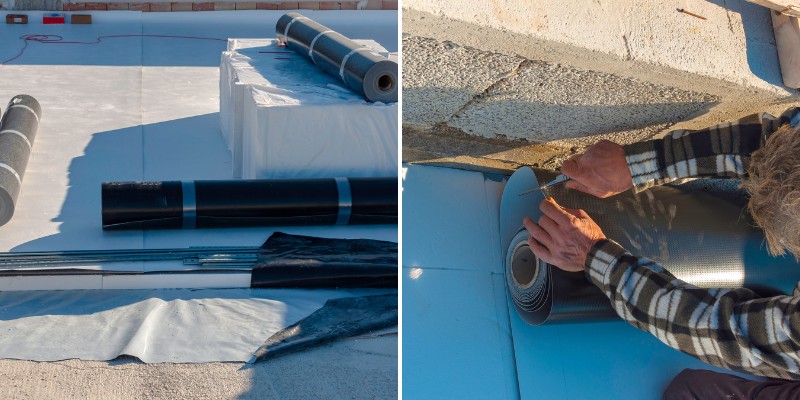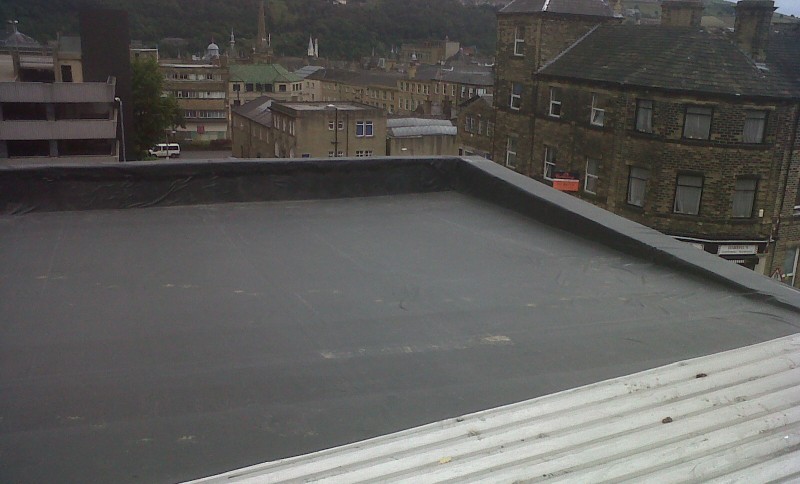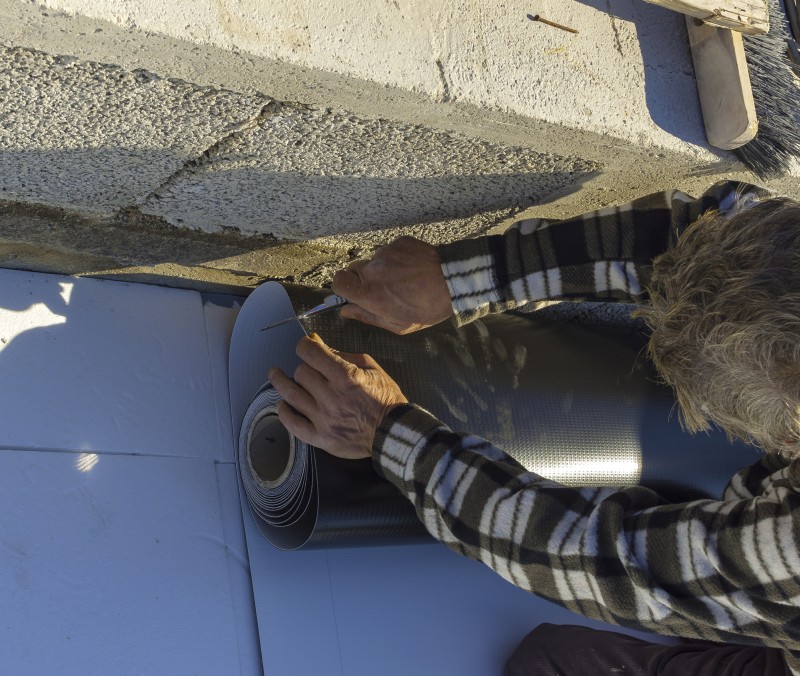You’re not imagining things if you have concluded that the world revolves around acronyms. From PDQ and ASAP to SCUBA (Self-Contained Underwater Breathing Apparatus) and SPF (Sun Protection Factor), your ability to de-code acronyms is part of 21st century living. The commercial and residential roofing industry is no exception.

As a matter of reference, professionals at This Old House divide flat roof materials into three categories: Built-up Roof (BUR), Modified bitumen and Rubber membrane (EPDM), adding more acronyms to this list.
The unique nature of rolled roof materials is diverse, thus you have clear choices once you consider the merits and downsides of EPDM vs TPO vs SBS, each of which is uniquely suited to areas of the country where they perform best and last for the longest amount of time.
But one thing all three have in common is that a qualified roofer is strongly recommended if a building owner hopes to maximize the roof’s lifetime.
This is no do-it-yourself project in light of both techniques and tools necessary to do a proper job so the roof lasts decades rather than years.
Many people ask the question “What does EPDM or TPO or SBS stand for in House Roofing?”.
In this article we’ll discuss, explain and compare these different types of rolled roofing materials along with their pros and cons etc, so let’s get started:
What is EPDM Roofing?
EPDM = ethylene propylene diene terpolymer material
In simple words, EPDM roofing is a single ply, elastomeric roofing sheet that is recommended for either re-roofing over a variety of deck types or installation on new roofs.

Acting as insulation, this rubber-like material resists fire, holds up to extremely low temperatures and it tolerates damaging wind, hail and UV radiation exposure.
Manufactured in lightweight rolls that are cold-applied to roof decks, this popular material requires a professional install if it is to perform to manufacturing standard over long periods of time.
EPDM Pros
- -EPDM provides a waterproof, temperature, moisture- and weather-resistant barrier that is also lightweight.
- -It is an environmentally-friendly material that is known to reflect UV rays and may reduce energy costs.
- -There are 3 installation options for EPDM: fully-adhered; mechanically attached or ballasted.
- -EPDM fits all deck shapes: flat, sloped, curved and spherical so it is easy to customize the roof finish.
- -This material requires minimal maintenance and fewer repairs; it is made to slow down the spread of fire.
- -Usually comes with manufacturer warranties and a life expectancy of 20 years or longer.
- -Compared to comparable, traditional roofing materials, EPDM is usually more affordable.
- -Most EPDM roofing materials are 100-percent recyclable so this material is environmentally friendly.
EPDM Cons
- -If installed incorrectly, the building loses all of the aforementioned benefits.
- -EPDM will only resist up to 3-inches of hail and catastrophic wind speeds could destroy the covering fast.
- -Installation costs using EPDM materials require specialized training that likely boost labor costs.
- -If you don’t stipulate “reinforced EPDM” products, the roof surface you choose may not be puncture-proof.
- -EPDM shrinks up to 4-percent over time, leading to “bridging” that makes a roof vulnerable to assaults.
- -Don’t skip twice-a-year inspections or you could risk the roof’s deterioration and longevity.
- -EPDM and petroleum-based products are incompatible. EPDM material can break down fast if contact is made.
- -Standard forms of EPDM come in black and may be aesthetically unsuitable for some buildings. White or patterned versions are available, but at a higher cost.
What is TPO Roofing?
TPO = thermoplastic polyolefin
What is thermoplastic polyolefin roofing? This alternate flat roofing material type has been around since the 1990s and offers residential and commercial builders a modern, simple look plus ultraviolet, ozone and chemical resistance once applied.

TPO comes in single ply rolls and installs uniformly. Heat-reflective and energy efficient, this material is usually a blend of polypropylene and ethylene-propylene rubber, offers reflective qualities and it is especially favored for use when roofing or re-roofing buildings in hot climates as TPO tolerates a lot of sunlight without breaking down.
TPO Pros
- -TPO can deliver up to 20 years of consistent protection; nearly twice the time projected for the survival of traditional roofing products.
- -TPO is one of the least expensive flat roof materials on the market, costing less than other products at an estimated material cost of between $1.5 and $5 per square foot.
- -The white side of TPO reflects sunlight, reduces indoor heat buildup, lowers cooling costs and carbon emissions. This roofing material exceeds Energy Star standards.
- -It’s easier and faster to install because it attaches directly to the deck and can be heat-welded around architectural features like chimneys. However, you will need electricity source to install.
- – The flexible nature of the membrane makes TPO very resistant to tears, punctures and impact damage.
- -TPO resists corrosion and is less likely to attract and host mildew or algae growth over time.
- -You don’t have to pressure wash TPO because it resists dirt build-up, punctures and other assaults.
- -Because it is so flexible, you could relocate the entire structure and the roof material will stay in place.
TPO Cons
- -TPO quality is not consistent from manufacturer to manufacturer, so do your homework before committing.
- -While TPO comes in many thicknesses, shady contractors have been known to promise longer roof life with thicker grades of this covering. That’s untrue.
- -There are more inferior types of TPO on the market that other roof materials in this niche.
- -Because material and fabrication changes have been dramatic within the roofing industry over time, you may not get 20+ years of roof life.
- -Lamination products used to seal TPO may create weak points leading to shrinking, cracking and deterioration.
- -TPO rolls are narrow so you could wind up using twice as much and being stuck with seams every 6-to-8 feet that can result in expansion and contraction.
- -Installation costs for TPO can get expensive, even on flat roofs, thus labor costs could escalate.
- -A torch is required to bond TPO to adhesives or the job won’t seal properly. The use of a torch adds an element of danger to the install.
What is SBS Roofing?
SBS = styrene butadiene styrene roofing
What is styrene butadiene styrene roofing? This material is one of two basic types of a roofing category known as modified bitumen membrane and consists of two options: Styrene butadiene styrene (SBS) and atactic polypropylene (APP).
SBS is a rubbery, elastic roof covering, while APP is a rigid plastic material that comes with the disadvantage of being more susceptible to cold climate damage.
Compared to SBS, APP is more brittle. While both offer advantages and disadvantages, industry professionals prefer SBS because it represents higher quality, versatility and better longevity.
SBS Pros
- -SBS is extremely flexible; it performs better in areas experiencing extreme temperature fluctuations.
- -Introduced in the U.S. in 1975, modifications over time have made SBS a very popular roofing alternative.
- -This roof membrane delivers the multi-layer benefits of a built-up roof in a single material application.
- -SBS comes in many different style options so it is possible to create a unique, custom deck or roof finish not available from competitor products.
- -SBS roof installations are extremely versatile. Contractors can employ torching techniques or use cold-applied methodologies depending upon the situation. As a result, torch danger could be eliminated from installation concerns.
- -SBS is not only recyclable but it can be reprocessed and used to construct new roads.
- -This material is ideal for repairing bituminous roofs if the owner wants to forestall an entire roof replacement.
- -Known for its versatility, SBS is chosen for both residential and commercial buildings and it can be paired with regular shingles to create a unique look that one roofer calls “eye candy.”
SBS Cons
- -Without a positive drainage system, a roof covered with single-ply SBS can deteriorate and shorten the roof’s life. At a minimum, a two-ply base/cap sheet should be used.
- -Despite a Class A fire rating, SBS may not perform as well as competitor products.
- -Due to detailing and tasks required to install SBS, labor costs can increase.
- -For SBS to meet longevity projections, proper seam adhesion, asphalt temperature and skilled torching techniques are critical or damage could result from ordinary assaults.
- -Smells and odors that are associated with an SBS installation can be offensive and the heated torch application method releases harmful fumes into the atmosphere. The smell may last for days.
- -SBS is not as resistant to impact damage from falling branches and hail as comparable roofing materials are, even with proper installation.
- -This roofing option is too fragile to be used on roofs and decks that will be subject to foot traffic. If installed under hot sun, roofers can damage the covering during the install; it’s just that fragile.
- -Not suited to roofs that experience ponding water conditions or latent moisture problems within the original roof system.
TPO Versus EPDM Roofing Materials
Both TPO and EPDM are excellent roofing materials for flat roofs. However, depending on your needs, one will serve better than the other.
Characteristics
TPO, or thermoplastic polyolefin, roofing is made out of a thermoplastic and rubber blend. Some manufacturers reinforce their blend with fiberglass to improve durability.
It is UV resistant, flexible, and durable. Many contractors that work with TPO roofing report that punctures, leaks, and mildew growth are almost nonexistent. It is usually sold in small-width rolls. TPO is newer to the market and has only been popular for a few years.
EPDM, or ethylene propylene diene terpolymer, is another rubber blend roofing material made out of rubbers that are derived from natural gas. It comes in widths ranging from 7.5 to 50 feet.
Color
TPO comes in several different colors ranging from white to gray to black. This makes it a better choice in hotter climates because it reflects sun light and offers additional protection from UV rays. Improve your comfort and lower your energy bills with this roofing system.
By contrast, EPDM roofing only comes in black or white. Black roofing absorbs heat and can drive your energy bills up, particularly in the summer, while the less common white color is impractical in the winter and absorbs more dirt.
Installation
TPO roofing is usually welded to your roof. This makes the roofing system more durable. However, it also means that installation and repairs are more complicated than with EPDM roofing.
You will need to figure out how to get an electricity source up to the roof and find an experienced welder comfortable with working at heights. It is possible to mechanically attach or glue TPO roofing, but the best results come with welding.
EPDM roofing can be applied using several different techniques. You can adhere the rubber to your roof with a special adhesive.
It can be mechanically attached, meaning that it is screwed into the deck. Some contractors also ballast EPDM roofing. Because there are several different installation methods, if you are an experienced DIYer you could even install your EPDM roofing yourself.
Life Span
Experts estimate that TPO roofing can last up to 20 years or more. However, because this product is so new, most people aren’t sure how long it can actually last through real-world conditions, and there are variations in quality and longevity between manufacturers.
EPDM roofing can last up to 30 years. There is a reason that this roofing material has been the most popular on the market for a long time. TPO is a strong newcomer, but it just cannot compete with EPDM in terms of longevity.
Weather Resistance
TPO is more resistant to punctures, mildew, and dirt than EPDM. If you live in a rainy climate, TPO is a better option that will protect your home or business from leaks.
However, EPDM is far more resistant to hail storms because it just bounces off hail, while TPO absorbs the damage. EPDM is also a better choice if you are planning to install solar panels as it does not interfere with the absorption of sunlight.
How to Tell the Difference Between TPO and EPDM?
You can tell the difference between TPO and EPDM just by looking at the two materials. TPO comes in more colors, while EPDM is usually black, sometimes white.
EPDM is matte while TPO has a shiny surface. You can also tell by touching it. EPDM is stretchier and bouncy to the touch, just like tire rubber, while TPO is harder.
You can also tell the difference by looking at the seams. TPO seams are almost always welded together, while EPDM seams are visible because they are fused with seam tape. EPDM will have fewer seams because it comes in wider rolls.
Is TPO More Expensive Than EPDM?
TPO is slightly more expensive than EPDM. EPDM usually costs anywhere between $1 to $4 per square foot. By contrast, TPO costs between $1.5 and $5 per square foot, which is slightly more expensive (these are material costs, not including labor).
Regarding labor cost, TPO also costs more to install (around $4 to $10 per square foot) since this type of material requires welding and thermal process to install.
On the contrary, EPDM labor costs around $4 to $8 per square foot.
Sometimes, the extra cost is worth it. TPO offers better insulation, UV protection, color options, and energy efficiency. However, if you are on a budget, then EPDM is the better choice.
Resources
https://www.thisoldhouse.com/roofing/21015399/3-flat-roof-types
https://bobbehrendsroofing.com/what-is-epdm-roofing/
https://www.bestroofing.net/blog/pros-and-cons-of-asphalt-based-systems-vs-single-ply
Related Posts
- What Type of Plywood is used for Roofing? Size and Thickness Guide
- Advantages and Disadvantages of Solar Roof Vents for Homes
- 10 Different Types of Snow Guards for Metal Roofs
- Advantages and Disadvantages of Roof Ridge Vents for Homes
- 5 Unique Roof Upgrades to Consider for Your Home
- Pros and Cons of TPO Roofing – Cost, Advantages, Disadvantages
I have quotes for a 12×26 flat roof on a sunroom addition. One says TPO, another SBS. It currently has SBS, about 20 yrs old. Michigan has a lot of gray days v sunshine. What is your recommendation? I like that there would be an insulation board under the TPO, & it’s sun-rays diversion. Also looking at gutter replacement w/guards on the house. Lots of decisions to make! Would greatly welcome any input.